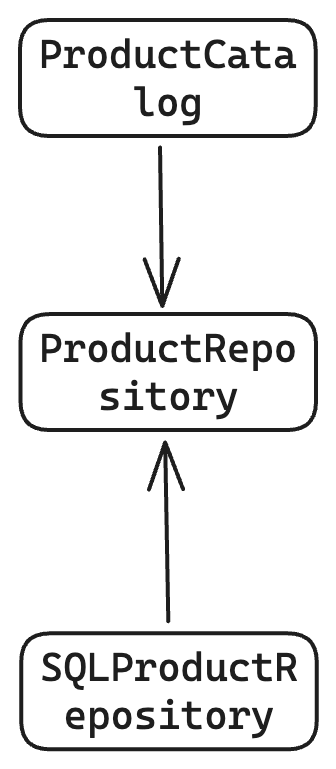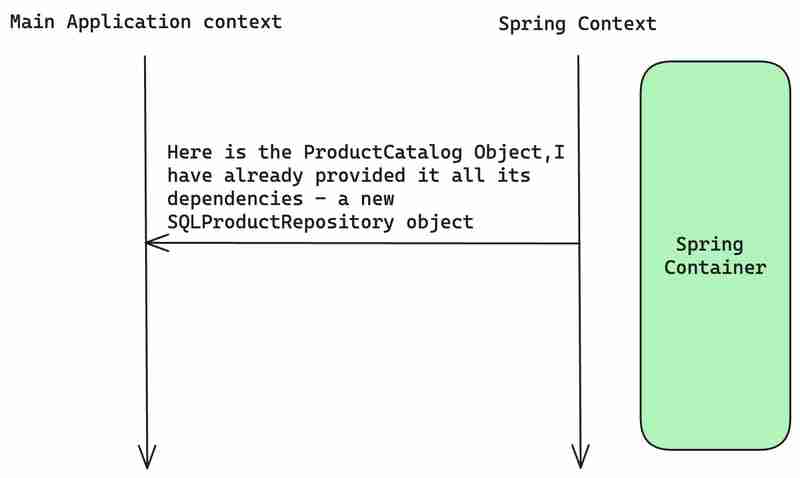Dependency Inversion Principle
High-level modules should not depend on low-level modules. Both should depend on abstractions.
Abstractions should not depend on details, details should depend on abstractions.
Let's understand the High-level modules and Low-level modules through an example:

In an e-commerce app like Flipkart on a high level it can be categorized as ProductCatalog, PaymentProcessor, and CustomerProfile (these are some of the main business functions)
These business functions interdepend on other modules shown in the above image.
Note: the modules on top are closer to a business function called High level modules.
The modules at the bottom are close to the implementation details called Low level modules.
Low-level modules are SQLProductRepository, GooglePayService, WireTransfer, EmailSender, and VoiceDialer.
If we consider CustomerProfile (High-Level module) and Communication modules alone then, Communication is a Low-level module but if we consider Communication, EmailSender, and VoiceDialer alone then, Communication becomes a High-Level module, and EmailSender and VoiceDialer are Low-Level modules.
The point here the concept of High and Low level module is not absolute but relative.
According to the image above ProductCatalog depends on SQLProductRepository i.e. a high-level module depends on a low-level module, but this directly conflicts with the DIP's 1st definition.
Let's take ProductCatalog → SQLProductRepository relationship and analyze it further.
import java.util.List;
/*
* High-Level module
*/
public class ProductCatalog {
public void listAllProducts(){
SQLProductRepository sqlProductRepository = new SQLProductRepository();
List<String> allProductsNames = sqlProductRepository.getAllProductNames();
//Display all products names
}
}
/*
* Low-level module
*/
import java.util.Arrays;
import java.util.List;
public class SQLProductRepository {
public List<String> getAllProductNames(){
return Arrays.asList("soap","toothpaste");
}
}
As ProductCatalog directly depends on SQLProductRepository this is clearly a violation of DIP definition 1 (as per the definition both High and Low-level modules should depend on abstraction)
Let's fix this as per definition 1:
creating interface ProductRepository
import java.util.List;
public interface ProductRepository {
public List<String> getAllProductNames();
}
Implementing this interface in SQLProductRepository
/*
* Low-level module
*/
import java.util.Arrays;
import java.util.List;
public class SQLProductRepository implements ProductRepository{
@Override
public List<String> getAllProductNames(){
return Arrays.asList("soap","toothpaste");
}
}
Finally for High level module ProductCatalog we should not directly instantiate SQLProductRepository in it. We will use a ProductFactory class for the same
public class ProductFactory {
public static ProductRepository create(){
return new SQLProductRepository();
}
}
We will use ProductFactory to instantiate the SQLProductRepository
/*
* High-Level module
*/
import java.util.List;
public class ProductCatalog {
public void listAllProducts(){
ProductRepository productRepository = ProductFactory.create();
List<String> allProductsNames = productRepository.getAllProductNames();
//Display all products names
}
}
Note our reference object is ProductRepository So, we don't have any tight coupling with SQLProductRepository
After the modification the new dependency will look something like this

The above changes are as per the DIP definition 1.
The above code change also follows the 2nd definition of DIP as well i.e. Abstraction should not depend on the details, details should depend on the abstraction.
As we can see in the image above SQLProductRepository depends on the ProductRepository not the other way around. This is the reason why this principle is called the Dependency Inversion Principle
Dependency Injection VS Dependency Inversion
Even though they are related, they are not the same and can not be used interchangeably
Understanding Dependency Injection:
In ProductCatalog we make use of the Factory method ProductFactory.create() to get an instance of SQLProductRepository object.
Though it delegates the instance creation process to the factory class ProductFactory, the initialization process is still with the ProductCatalog class.
Ideally, we don't want ProductCatelog class to worry about how and when to trigger the instantiation.
What if we provide the instantiated ProductRepository class to ProductCatalog even without it asking?
So, the Main class ECommerceMainApplication makes use of the factory method ProductFactory.create() to create the instance of ProductRepository and this instance is passed as an argument in the constructor of ProductRepositroy class.
public class ECommerceMainApplication {
public static void main(String agrs[]) {
ProductRepository productRepository = ProductFactory.create();
ProductCatalog productCatalog = new ProductCatalog(productRepository);
productCatalog.listAllProducts();
}
}
After updating the ProductCatalog class accordingly
import java.util.List;
public class ProductCatalog {
private ProductRepository productRepository;
public ProductCatalog(ProductRepository productRepository) {
this.productRepository = productRepository;
}
public void listAllProducts(){
List<String> allProductsNames = productRepository.getAllProductNames();
//Display all products names
allProductsNames.forEach(product-> System.out.println(product));
}
}
Now the ProductCatalog is free to use the SQLProductRepository object whenever and wherever it wants. It no longer has not worry about creating the SQLProductRepository object on its own.
In other words we are injecting the dependency into the ProductCatalog instead of ProductCatalog worrying about instantiating the dependency.
This is the concept of dependency injection
Inversion of control - IOC
Even though it is not part of DIP(Dependency Inversion Principle), it is closely related
Let us understand this with the same above code
The class ProductCatalog had a constructor that took in ProductRepository object.
The class that calls the ProductCatalog will provide or inject the object of ProductRepository in this case it is ECommerceMainApplication.
Note, even though the injection happens outside of the ProductCatalog class, the injection still happens during the main flow of the program. i.e. the injection is happening in the main thread of the program execution.
What if we want all the injections to happen in a separate thread or a separate context altogether So that the main control flow is completely isolated from the injection?
This can be achieved using frameworks like Spring(in Java).

Spring will run its own context different from the main flow of the program
Spring will take care of injecting the required dependencies of a class. So if you want to instantiate the object of a class, instead of doing it yourself directly in the code, you ask Spring to give you the object of the class.
The Spring framework looks at all the dependencies required for the instantiation of the object, then goes ahead and injects all the dependencies, instantiates the object, and gives it back to the main control flow.
Thus the control over dependency injection is completely delegated to the Spring framework and does not happen in the mail control flow.
This concept is called Inversion of Control (IOC) and the Spring is called Inversion of Control Container or simply an IOC Container
The above is the detailed content of Dependency Inversion Principle. For more information, please follow other related articles on the PHP Chinese website!

Hot AI Tools

Undresser.AI Undress
AI-powered app for creating realistic nude photos

AI Clothes Remover
Online AI tool for removing clothes from photos.

Undress AI Tool
Undress images for free

Clothoff.io
AI clothes remover

Video Face Swap
Swap faces in any video effortlessly with our completely free AI face swap tool!

Hot Article

Hot Tools

Notepad++7.3.1
Easy-to-use and free code editor

SublimeText3 Chinese version
Chinese version, very easy to use

Zend Studio 13.0.1
Powerful PHP integrated development environment

Dreamweaver CS6
Visual web development tools

SublimeText3 Mac version
God-level code editing software (SublimeText3)

Hot Topics
 1663
1663
 14
14
 1420
1420
 52
52
 1315
1315
 25
25
 1266
1266
 29
29
 1239
1239
 24
24
 Is the company's security software causing the application to fail to run? How to troubleshoot and solve it?
Apr 19, 2025 pm 04:51 PM
Is the company's security software causing the application to fail to run? How to troubleshoot and solve it?
Apr 19, 2025 pm 04:51 PM
Troubleshooting and solutions to the company's security software that causes some applications to not function properly. Many companies will deploy security software in order to ensure internal network security. ...
 How do I convert names to numbers to implement sorting and maintain consistency in groups?
Apr 19, 2025 pm 11:30 PM
How do I convert names to numbers to implement sorting and maintain consistency in groups?
Apr 19, 2025 pm 11:30 PM
Solutions to convert names to numbers to implement sorting In many application scenarios, users may need to sort in groups, especially in one...
 How to simplify field mapping issues in system docking using MapStruct?
Apr 19, 2025 pm 06:21 PM
How to simplify field mapping issues in system docking using MapStruct?
Apr 19, 2025 pm 06:21 PM
Field mapping processing in system docking often encounters a difficult problem when performing system docking: how to effectively map the interface fields of system A...
 How does IntelliJ IDEA identify the port number of a Spring Boot project without outputting a log?
Apr 19, 2025 pm 11:45 PM
How does IntelliJ IDEA identify the port number of a Spring Boot project without outputting a log?
Apr 19, 2025 pm 11:45 PM
Start Spring using IntelliJIDEAUltimate version...
 How to safely convert Java objects to arrays?
Apr 19, 2025 pm 11:33 PM
How to safely convert Java objects to arrays?
Apr 19, 2025 pm 11:33 PM
Conversion of Java Objects and Arrays: In-depth discussion of the risks and correct methods of cast type conversion Many Java beginners will encounter the conversion of an object into an array...
 How to elegantly obtain entity class variable names to build database query conditions?
Apr 19, 2025 pm 11:42 PM
How to elegantly obtain entity class variable names to build database query conditions?
Apr 19, 2025 pm 11:42 PM
When using MyBatis-Plus or other ORM frameworks for database operations, it is often necessary to construct query conditions based on the attribute name of the entity class. If you manually every time...
 E-commerce platform SKU and SPU database design: How to take into account both user-defined attributes and attributeless products?
Apr 19, 2025 pm 11:27 PM
E-commerce platform SKU and SPU database design: How to take into account both user-defined attributes and attributeless products?
Apr 19, 2025 pm 11:27 PM
Detailed explanation of the design of SKU and SPU tables on e-commerce platforms This article will discuss the database design issues of SKU and SPU in e-commerce platforms, especially how to deal with user-defined sales...
 How to use the Redis cache solution to efficiently realize the requirements of product ranking list?
Apr 19, 2025 pm 11:36 PM
How to use the Redis cache solution to efficiently realize the requirements of product ranking list?
Apr 19, 2025 pm 11:36 PM
How does the Redis caching solution realize the requirements of product ranking list? During the development process, we often need to deal with the requirements of rankings, such as displaying a...




